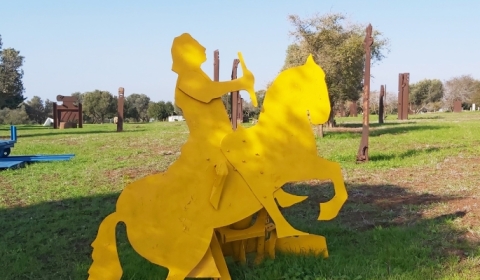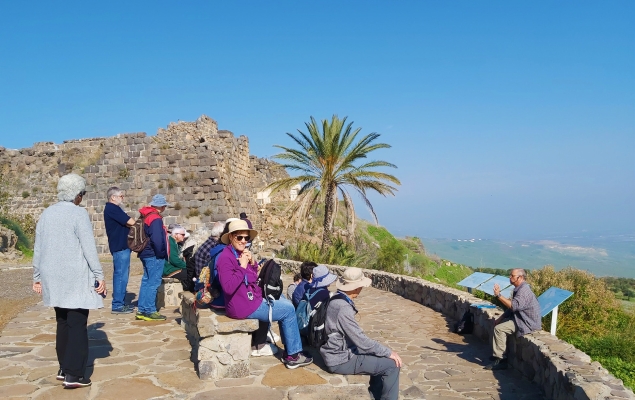Kohav Hayarden (Belvoir) National Park
Text and Photos: Lydia Aisenberg
On a windswept, basalt rock plateau looming 300 meters above sea level, and overlooking a wide expanse of the fertile Jordan Valley an astounding 550 meters below, is a sprawling, open air sculpture park. These intriguing, challenging and often rather brutal-looking works of art were created by the late Igael Tumarkin, one of Israel's most controversial and highly influential artists and sculptors.
The Igael Tumarkin sculpture exhibition site is adjacent to the partially reconstructed Crusader fortress, built of black basalt rock, of Kohav HaYarden (Belvoir). The fortress was aptly described by Muslim historians of the 12th century CE as "a nest of eagles and the dwelling place of the moon."
Tumarkin's works, open to the elements on this rocky mountain top, stand near the site where bloody battles raged in bygone days. This exhibition is a novel collaboration between the Israel National Parks Authority and Tumarkin – the artist, sculptor and creator of monuments and memorials found throughout Israel, whose works exhibited at Kohav HaYarden are inspired by the fortress and the violent events that took place there.
Some of Tumarkin's gigantic pieces on display at Belvoir are painted in bright yellow or sky blue and dark blue. The bright colors of the sculptures do not take away one iota of the impact of the cruelty, despair and suffering caused by generations of conflict and personal tragedy brought upon man by fellow human beings, whether it be thousands, hundreds or scores of years ago … nor unfortunately, in present times.
From this vantage point the majestic Gilead Mountains of Jordan can be seen clearly across the valley floor. The valley between the two mountain ranges is heavily dotted with Israeli agricultural communities on the western side of the Jordan river, which wends slowly southward from the Sea of Galilee to the Dead Sea, with their Jordanian farming counterparts on the eastern banks.
An observation platform, named after the late General Dan Shomron, a former Chief of Staff of the Israel Defense Forces and commander of Operation Entebbe, is situated atop the Ramat Kochav plateau, affording a bird's eye – or eagle's eye – view of the region. Visitors can well understand why the Crusaders chose this highly strategic position that controls from above the main road running along the valley floor, and also overlooks three of the most important crossings of the River Jordan. These are at Zinbari, south of the Sea of Galilee, Naharayim at the then confluence of the Jordan and Yarmuk rivers, and also another major crossing situated east of Beit Shean.
The Kohav Hayarden (Belvoir) National Park, which includes the thought-provoking and somewhat daunting Tumarkin sculptures and the Crusader fortress, is accessible by a twisting, turning road that affords absolutely breathtaking, almost kaleidoscopic views of the bleak eastern Galilee mountain range. Sparse areas of greenery interchange starkly with glorious views of an extensive patchwork of lush green, yellow, orange and brown fields and a number of irrigation reservoirs down below – if you are okay with looking out of the vehicle's window that is!
Kohav HaYarden stands on land the Hospitalier Knights purchased from a French noble family. The fortress they constructed there is considered to be one of their greatest architectural achievements. In present times you can stand in the reconstructed knights' dining hall, take in the amazing views in every direction from the many ramparts, and even discover a secret entrance – well, obviously not a secret anymore but still fascinating – and far more.
Somewhat out of place but eye-poppingly awesome, is the ongoing construction – on the lower slopes of the mountain – of a massive hydroelectric plant, developed together with the Power Construction Corporation of China. When completed it will be the lowest pumped storage power plant in the world, since its turbines will be ensconced some 275 meters below sea level.
Two reservoirs, one at the base of Kohav HaYarden and a much larger one adjacent to the Crusader fortress on the upper reaches of the mountain range, are almost completed. Approaching a flatter area at the crest of the mountain range and swinging around a sharp bend on the ascent toward to the fortress itself, seemingly out of nowhere, a huge oval shaped reservoir suddenly appears almost like an apparition, absolutely breathtaking in size and shape and truly astonishing.
In the 18th century, an Arab village was established within the remains of the Crusader fortress and aptly named Kaukab el-Hawa, meaning the "star of the winds". During the 1948 War of Independence, the site was conquered by soldiers from the Golani Brigade following fierce battles with the Iraqi army on the slopes leading up to the ruins of the Crusader-built fortification.
A 400-meter scenic track is tucked under the outer walls of Belvoir and known as the Way of the Friend. The path leads to a memorial dedicated to British Army officer Major General Orde Wingate, known in Hebrew as HaYadid (the friend) and revered for being a staunch supporter of the Zionist cause. General Wingate was the creator of the SNS – Special Night Squads – credited with saving many Jewish communities from destruction during the 1936-1939 Arab Revolt. He was also instrumental in the training of Jewish fighters who would later form the very core of the Israel Defense Forces and some political leaders of the State of Israel.









Comments